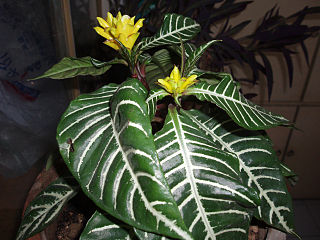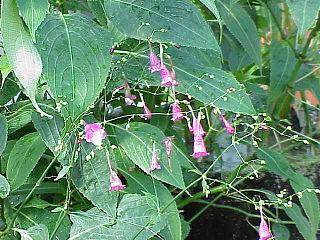
Acanthaceae is a family of dicotyledonous flowering plants containing almost 250 genera and about 2500 species. Most are tropical herbs, shrubs, or twining vines; some are epiphytes. Only a few species are distributed in temperate regions. The four main centres of distribution are Indonesia and Malaysia, Africa, Brazil, and Central America. Representatives of the family can be found in nearly every habitat, including dense or open forests, scrublands, wet fields and valleys, sea coast and marine areas, swamps, and mangrove forests.

Justicia is a genus of flowering plants in the family Acanthaceae. It is the largest genus within the family, encompassing around 700 species with hundreds more as yet unresolved. They are native to tropical to warm temperate regions of the Americas, India and Africa. The genus serves as host to many butterfly species, such as Anartia fatima. Common names include water-willow and shrimp plant, the latter from the inflorescences, which resemble a shrimp in some species. The generic name honours Scottish horticulturist James Justice (1698–1763). They are closely related to Pachystachys.

Aphelandra is a genus of about 170 species of flowering plants in the family Acanthaceae, native to tropical regions of the Americas.

Barleria is a genus of plants in the family Acanthaceae.

Andrographis is a genus of flowering plants in the family Acanthaceae. They may be generally known as the false waterwillows, and several are called periyanagai.

The genus Asystasia belongs to the family Acanthaceae and comprises approximately 70 species found in the tropics, including the weedy species Asystasia gangetica.

Peristrophe was a genus of up to 40 species of flowering plants: that are now usually considered synonyms in the genus Dicliptera Juss.
Anisotes is a genus of Afrotropical plants in the family Acanthaceae. The genus is morphologically similar to Metarungia, from which it differs mainly in the dehiscence of the fruit capsule, and the nature of the placenta. Placentas remain attached to the inner surface of fruit capsules in Anisotes.
Johannes Conrad Schauer was a botanist interested in Spermatophytes. He was born in Frankfurt am Main and attended the gymnasium of Mainz from 1825 to 1837. For the next three years he worked at the Hofgarten of Würzburg. Schauer then gained a position as assistant at the botanical garden at Bonn where he worked until 1832 when he was placed in charge of the botanic garden in Breslau, with C.G. Nees. He gained the degree of Doctor of Philosophy at the University of Erlangen-Nuremberg 1835 and was appointed professor of botany at the University of Greifswald from 1843 until his death in 1848.

Tetramerium is a genus of plants belonging to the family Acanthaceae. It is found mainly in the Americas, especially in tropical dry forests. Christian Gottfried Daniel Nees von Esenbeck first described the genus in 1846 after collecting two species on the journey of HMS Sulphur.

Oplonia spinosa, the pricklybush, is a species of plant in the family Acanthaceae, endemic to several Caribbean islands. It is a spiny shrub ranging in height from dwarf to 3 meters, with curved spines 4–12 mm long, and leaves variable in size and shape.

Eranthemum is a genus of plants in the family Acanthaceae.
John Gillies (1792–1834) was a Scottish naval surgeon who later became an explorer and botanist, travelling extensively in South America. Educated at the University of Edinburgh, he served in the Royal Navy during the Napoleonic Wars. Afflicted by tuberculosis, Gillies left the UK aged 28 for South America in the hope that the climate would improve his fragile health. He spent eight years there, mostly in Argentina, surviving wars, civil unrest, and chronic ill health, sending numerous plants to Hooker at the Royal Botanic Gardens Kew before returning in 1828. He died aged 42 at Edinburgh on 24 November 1834, his remains interred at Calton.

Schaueria is a genus of flowering plants in the family Acanthaceae. They are endemic to Brazil, from Bahia to Rio Grande do Sul. They are characterized by small elongated white or yellow flowers and narrow to thread-like green or yellow bracts. They are found mainly in rain forests, semi-deciduous mountain forests, and restingas. They are pollinated by bees and hummingbirds.

Dicliptera tinctoria is the accepted name of a species in the family Acanthaceae. It may be called magenta plant, or lá cẩm in Vietnamese and native to southeastern Asia from Assam south to Sri Lanka and east to mainland Southeast Asia, Java, southern China, and Taiwan.

Acanthoideae is a subfamily of plants in the family Acanthaceae.
Thyrsacanthus is a genus of flowering plants in the family Acanthaceae, found in South America east of the Andes, typically in drier areas. Perennial shrubs, they were resurrected from Anisacanthus in 2010, leaving it with the North American species.
Codonacanthus is a genus of flowering plants belonging to the family Acanthaceae.
Rhaphidospora is a genus of flowering plants belonging to the family Acanthaceae. A classification of the Acanthaceae published in 2022 treats Rhaphidospora as a synonym of Justicia.













